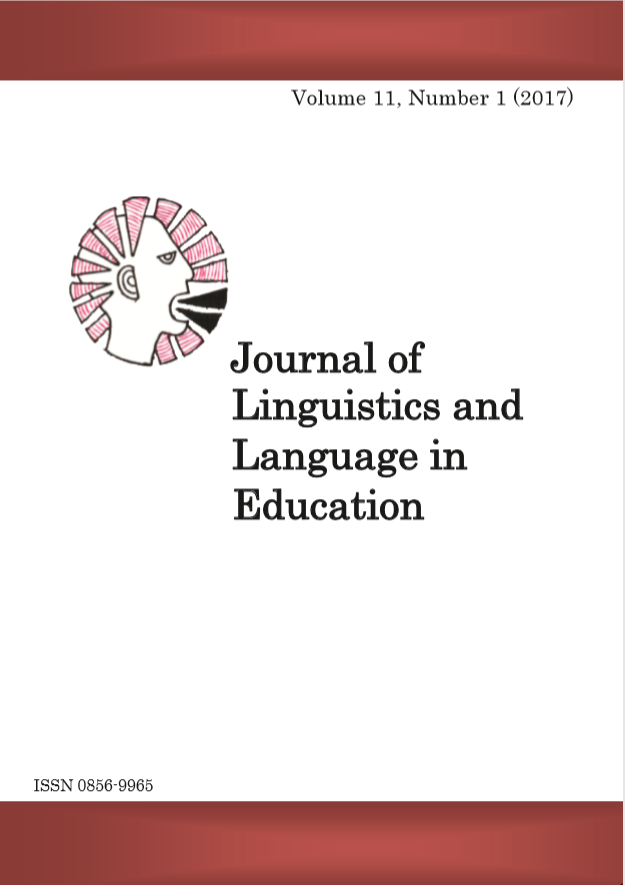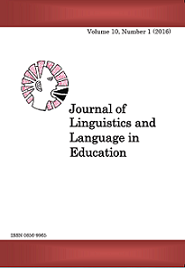What a Video Queen is to a Male Artist: the Social-Semiotic Analysis of Music Videos and Lyrics in Tanzania
Abstract
This paper is set to examine the representation of women by male artists in
bongo flava. It aims at disclosing the discursive practices taking place between
men and women in the music industry. The study used Teo van Leeuwen ' s
social semiotics to analyze the data through exclusion, role, specific and
general, and categorization. The linguistic analysis showed that a woman is
subservient to man; she is permissive with her body, allowing the camera to
focus on her boobs and buttocks. The dancing styles and flaunting are to attract
the viewing audience. In the lyrics she is a harlot, slut, lunatic, killer, involved
in commercial sex, unsettling in relationships and all she sees is money.
Interviews with male artists show her as a means to the male artists ' end, she
is ready to do anything for money because she is a prostitute. Focused group
participants, being unsophisticated viewers, do not take this woman to be a
special kind of woman; she represents other women rather than the ones she is
categorized with. She is a product of the habitus whose socio-cultural and
economic situation needs to be interrogated.
Key words: bongo flava, bongo movie, discursive practices, video queen, social
semiotic analysis, Tanzania; wadangaji
References
References
Bourdieu, P. (1990). The Logic of Practice. Stanford, CA: Stanford
University Press.
Fairclough, N. (1989). Language and Power. London:
Longman.
Goffman, E. (1976). Gender Advertisements. Studies in the
Anthropology of Visual Communication. New York:
HarperCollins.
Habermas, J. (1975). Legitimation Crisis. Boston: Beacon Press.
Halliday, M. A. K. & Hassan, R. (1989). Language, Context and Text:
Aspects of Language in a Social Semiotic Perspective. Oxford:
Oxford University Press.
Jackson, B. (1989). A History of Afro-American Literature. Volume 1:
The Long Beginning. Baton Rouge: Louisiana State
University: 1746 €“1895.
| What a Video Queen is to a Male Artist
Jurist, E. L. (2000). Beyond Hegel and Nietzsche: Philosophy,
Culture and Agency. London: The MIT Press.
Kress, G. & Hodge, R. (1988). Social Semiotics. New York: Cornell
University.
Kress, G. & van Leeuwen, T. (2006). Reading Images. The Grammar
of Visual Design. London: Routledge.
Ndulute, C. (1996). Women ' s Image in Kiswahili Novels: Rosa
Mistika and the Making of a Rebel. In D. A. S. Mbilinyi & C.
K. Omari (eds.). Gender Relations and Women ' s Images in the
Media. DUP: Dar es Salaam: 147 €“158.
Ng ' imba, H. (forthcoming) Women ' s View of Womanhood in Kitchen
Party Talks in Dar es Salaam: A Critical Discourse Analysis
Perspective. PhD Dissertation University of Dar es Salaam.
Omari, S. (2009). Tanzanian Hip Hop Poetry as Popular Literature.
PhD Unpublished Thesis (Literature) University of Dar es
Salaam.
Richards, A. R. (2012). Gender, Hegemony, and Country Music.
Gonzaga University, ProQuest Dissertations Publishing,
Ransom, P. (2015). Massage in Music: Do Lyrics influence well-
Being? Pennyslvania: Penn Libraries.
Shartielly, E. N. (2005). The Portrayal of the Tanzanian woman in
the TV Commercials: Is a Piece of Soap, a House, or Gold?
African & Asia Languages Journals, 5.
Strachan, G; Adikaram, A. & Kailasapathy, P. (2015). Gender
(In)Equality is South Asia: Problems, Prospects and
Pathways. https://doi.org/10.1177/2322093715580222.
Sylvester, V. M. (2005). Understanding the Writings of Nigerian
Women. In: Sylvester-Melomodile, V. & Mba, N.C. (2010).
"Literature and the Advancement of Gender Balancing in
Nigeria", US-China Foreign Language, 8(11): 107 €“116.
Van Leeuwen, T. (1996). "The Representation of Social Actors." In C.
R. Caldas-Coulthard and M. Coulthard (eds.). Texts and
Practices: Readings in Critical Discourse Analysis. London:
Routledge: 32 €“70.
Van Leeuwen, T. (2005). Introducing Social Semiotics. New York:
Routledge.
Van Leeuwen, T. (2008). Discourse and Practice. New York: Oxford
University Press.
Varien, M. D. & Potter, J. M. (2008). The Social Construction of
Communities: Agency, Structure, and Identity in the
Prehispanic Southwest. Plymouth: AltaMira Press
Hyasinta Izumba and Antoni Keya |65
Wodak, R. (2001). What is CDA about: A Summary of its History,
Important Concepts and its Developments. In R. Wodak & M.
Meyer (eds.). Methods of Critical Discourse Analysis. London:
Sage: 1 €“13.
Wallis, C. (2010). Performing Gender: A Content Analysis of Gender
Display in Music Videos. Sex Roles, 64(3 €“4): 160 €“172.
Ward, L. M. (2002). Does Television Exposure Affect Emerging
Adults Attitudes and Assumptions about Sexual
Relationships? Correlational and Experimental Confirmation.
Journal of Youth and Adolescence, (31): 1 €“15
Downloads
Published
Issue
Section
License
Copyright © by Department of Foreign Languages and Linguistics, University of Dar es Salaam
All rights reserved. No part of this publication may be reproduced or transmitted in any form or by any means, electronic or mechanical, including photocopying, recording, or any information storage or retrieval system, without permission in writing from the publisher, except for short extracts in fair dealing, for research or private study, critical scholarly review or discourse with an acknowledgement.



